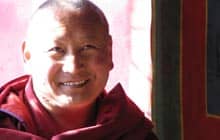The short article, Occult Universe, presents the basic patterns of belief current in China from the third millenium BC. It introduces the Book of Changes , which was as influential in the development of Confucianism as it was in much Daoist doctrine. Yet whereas Confucius expanded this book's social implications, Daoism elaborated on its metaphysical claim – to understand the invariable laws controlling the process of change in the universe. » Read more »
» Read more »In the introductory article on the Occult Universe we establish the the basic model of Chinese thought which Confucius inherited. His contribution was to imbue this primtive but complex system with a moral value. For Confucius was an innovative conservative. While upholding all the ceremonial rituals of the existing cultural model, he gave them a moral significance of his own making.
In this short article, after introducing Confucius and principal ideas, » Read more »
» Read more »To understand how Tibetan Buddhism differs from other Buddhist schools we need to consider its development from two different perspectives, the first ideological and the second historical. Although these are here considered separately, they of course developed with reference to each other.
Ideological Development
Ideologically Tibetan Buddhism is a derivation of Mahayana Buddhism heavily influenced by Tantrism. To unravel this jargon-cloaked statement, we should take a look at the essential constituents and development of Buddhism, » Read more »
» Read more »Buddhism is said to have traveled into China along the Silk Road in the first half of the first century AD. Its rise to prominence grew in proportion to the increasing traffic along the Silk Road, so that by the Tang dynasty (618-907AD) when China's capital, Chang'an, was one of the world's most prosperous cities, Buddhist translations were for the first time accessible. It was during this period that a new variant of Buddhism arose, » Read more »
» Read more »Foundation of the Gelug Sect
Tsong Khapa (1357-1419) founded Ganden monastery in 1409. A graduate of the austere Karmapa order, his doctrine emphasized monastic discipline. This attitude was echoed by his reinforcement of the primacy of sutras – the original teachings of Buddha – over the tantras – later mystical teachings. So popular was his movement that new monasteries were soon opened at Sera, Drepung & Tashilhunpo, and the sect took on the name of Gelug or "Virtuous Ones". » Read more »
» Read more »